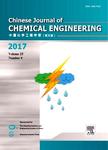Mathematical Model of Gas Permeation Through PTFE Porous Membrane and the Effect of Membrane Pore Structure
Mathematical Model of Gas Permeation Through PTFE Porous Membrane and the Effect of Membrane Pore Structure作者机构:College of Chemical Engineering Beijing University of Chemical TechnologyBeijing 100029 China Textile Institute Donghua University Shanghai 200051 China Textile Institute Donghua UniversityShanghai 200051 China
出 版 物:《Chinese Journal of Chemical Engineering》 (中国化学工程学报(英文版))
年 卷 期:2003年第11卷第4期
页 面:383-387页
核心收录:
学科分类:0710[理学-生物学] 0830[工学-环境科学与工程(可授工学、理学、农学学位)] 081704[工学-应用化学] 0817[工学-化学工程与技术] 08[工学] 081701[工学-化学工程] 0703[理学-化学]
基 金:Supported by the 863 Hi-Tech. Research and Development Program of China (No. 2002AA649280 No. 2002AA304030) National Natural Science Foundation of China (No. 20206002) Beijing NOVA program (H013610250112) University Doctor Science Foundation of China
主 题:porous membrane gas permeability mathematical model
摘 要:Membrane-based separation processes are new technology combined membrane separation with conventional separation. Hydrophobic porous membranes are often used in these processes. The structure of hydrophobic porous membrane has significant effect on mass transfer process. The permeabilities of five kinds of gas, He, N2, O2, CO2 and water vapor, across six polytetrafluoroethylene(PTFE) flat membranes were tested experimentally. Results indicated that the greater the membrane mean pore size and the wider the pore size distribution are, the higher the gas permeability. A gas permeation model, including the effects of membrane structure parameter and gas properties, was established. A comprehensive characteristic parameter (including porosity, thickness and tortuosity) was found more effective to express the influence of membrane structure in gas permeation process. The predicted permeation coefficients were in good agreement with experimental data.



